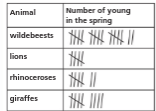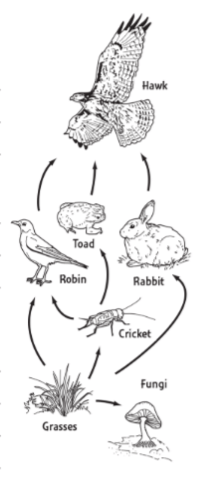A __(1)__ makes its own food for survival and a ___(2)___ eats plants or other animals to get energy
1) Producer
2) Consumer
What are examples of Natural Resources?
Renewable: Plants, animals, wind, water, sunshine
Nonrenewable: Rocks, Minerals, Fossil Fuels, soil, and land.
What do we all get our energy from? Think of modeling a food web.
The sun
What are different examples of ecosystems?
Polar Ecosystem, African Ecosystem, Desert Ecosystem, etc.
What is pollution?
Pollution is anything that makes the earth unhealthy and dirty.
A(n) __________ is a community of organisms and the physical environment in which they live.
Ecosystem
If Limestone is a type of rock that takes many years to form but is commonly used for road construction and in buildings. What kind of resource is limestone?
Nonrenewable
List the order of how energy flows in a food web.
Decomposer, sun, consumer, and producer
Sunlight--> Producer--> Consumer--> Decomposer
What is the difference between a community and a population?
A community is made up of all of the organisms that live in one place. Example: Zebras, giraffes, elephants, and even the grass are all parts of a community.
A population is just one kind of an animal living in an ecosystem. Example: Zebras might live in the same community as elephants but, all of the zebras are in a population.
What are the three different things on our planet that can be polluted?
Air, water, and soil
A _____________ is all of one kind of animal living in an ecosystem.
Example: All of the frogs living in a pond.
Population
Pick the item made from a RENEWABLE resource from the list below:
- Wooden Furniture
- Computer Keyboards
- Plastic Bags
Wooden Furniture.
We use trees to make things such as paper and wooden furniture.
We can recycle plastic bags BUT they are not originally made from a renewable resource
When Walmart was built, it took place of a pond habitat where a frog population was living. What most likely happened to the frog population?
The population most likely decreased.
What is the difference between a habitat and a niche?
A habitat is the part of the ecosystem that meets the needs of an organism. Example: Food and shelter.
A niche is the organism's role in the habitat. The way they interact with their habitat.
Plastic, metal, glass, and paper can all be ____________.
Think of the blue bin we have in our classroom.
Recycled
A _______ is a place in the environment that meets the needs of an organism.
Habitat
Coal and oil are what type of natural resource?
Nonrenewable
Think of the relationship between a snake and a mouse.
Where in a food web would a carnivore be placed? Where in a food web may a herbivore be placed?
Herbivore, sunlight, plants, carnivore
Sunlight --> plants --> herbivore --> carnivore

List the amount in each population from least to greatest.
Least:
- 5 Lions
- 7 Rhinoceroses
- 9 Giraffes
- 17 Wildebeests
Give an example of a producer and an example of a consumer.
Consumer: Owl
Producer: Mouse
A ________ is the organism's role in its habitat.
Niche
When our liter and pollution goes into water, where does it all go?
The liter and pollution all travels to the ocean. This means that all of the water is affected.
1) If birds eat insects and snakes eat birds, what would happen to the bird population if the insect population increased?
2) What would happen to the insect population if the snake population increased?
1) If the insect population increased, the bird population would increase as well.
2) If the snake population increased, the bird population would decrease. If the bird population decreases, the insect population would increase
An organism whose whole kind is at risk of dying is known as a(n) ___________ species
An endangered species.
Sea Turtles, Gorillas, Tigers, Rhinos, and Amur Leopards are all endangered species.
They are at risk of going extinct which means that they will no longer exist.

List the following:
- Producers: ________________________
- Consumers: _______________________
- Decomposers: ______________________
- Producers: Grasses
- Consumers: Cricket, robin, hawk, rabbit, toad
- Decomposer: Fungi